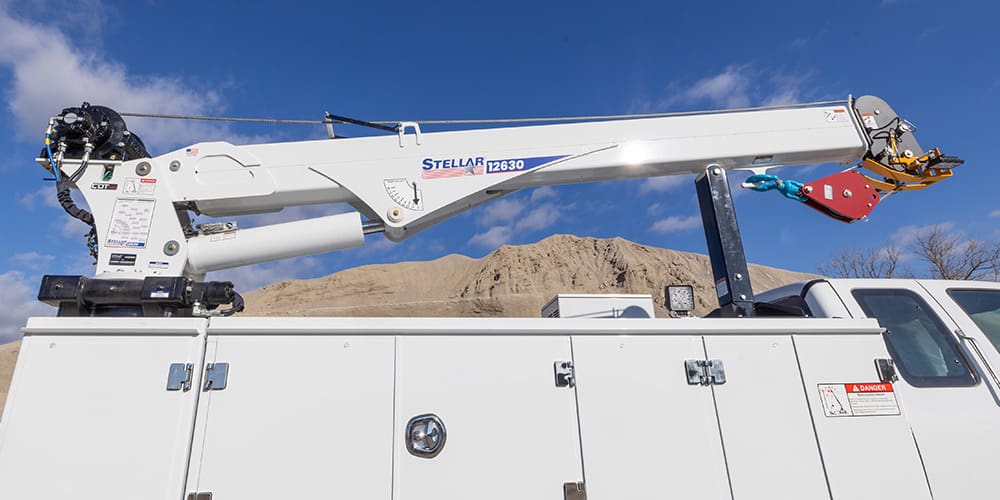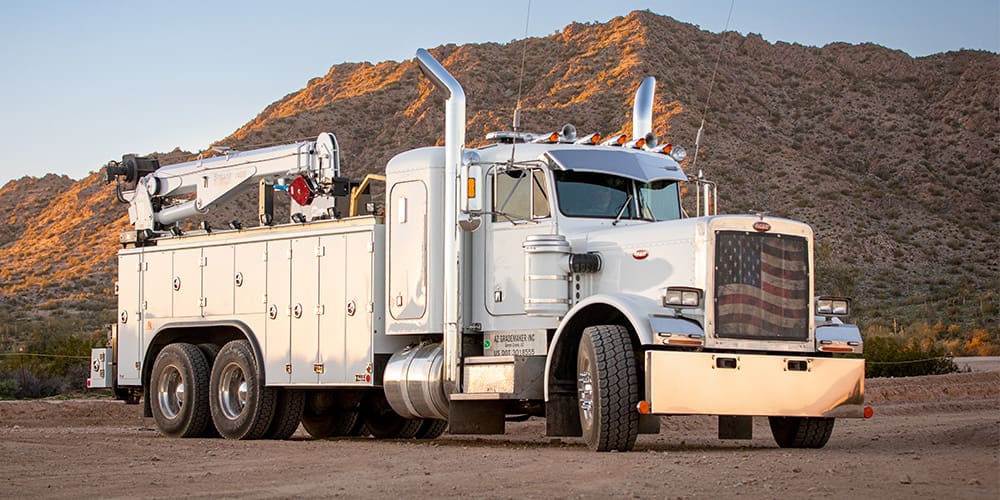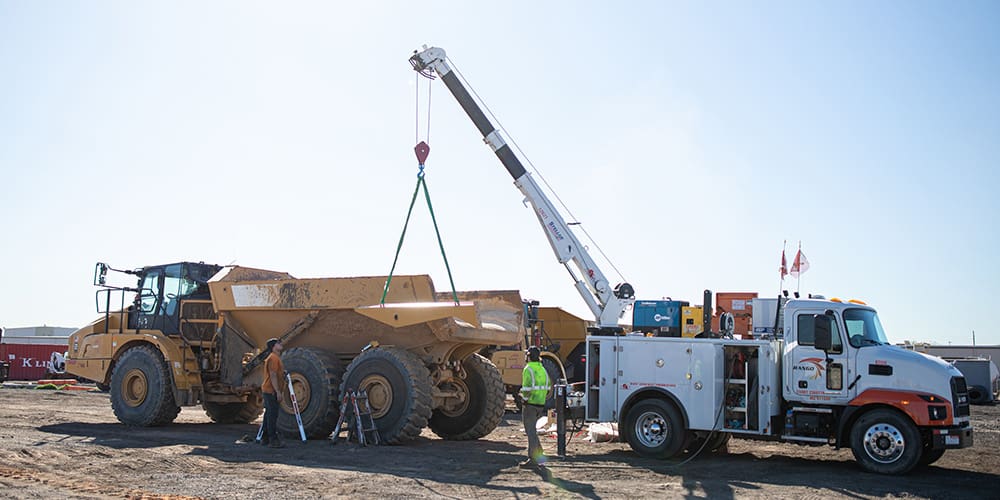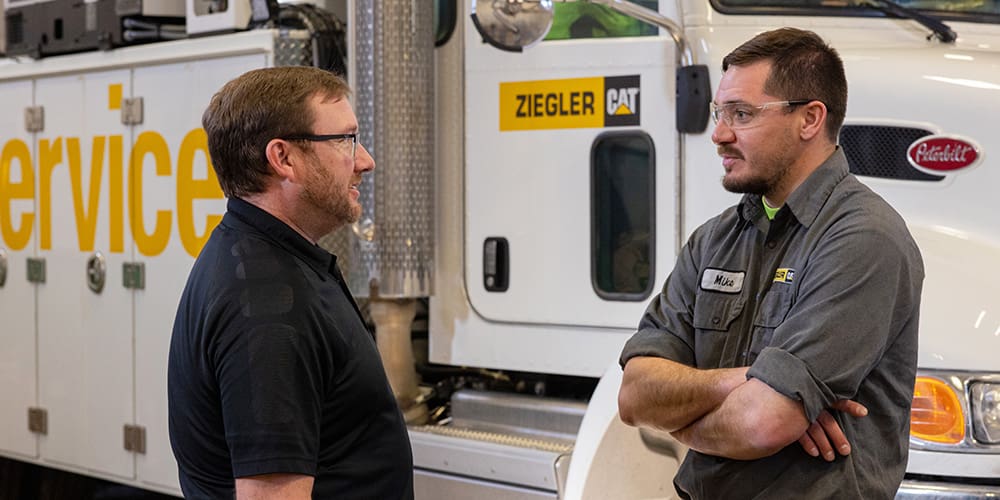How To Build a Mechanic Truck that Works for You
02.28.24

In the dynamic world of heavy-duty industries, the demand for reliable onsite support has never been higher. Mechanic trucks, with their durability and versatility, have become the backbone of many operations. These specialized trucks bring the mechanic shop to the jobsite, providing on-the-spot maintenance and repairs — minimizing downtime and maximizing operational efficiency.
One of the primary advantages of mechanic trucks is their ability to be configured to meet the unique needs of various industries. From construction sites to oil fields, these trucks offer a level of onsite support that can significantly impact your bottom line.
In this article, we’ll delve into some of the options available when building a mechanic truck, offering a guide to help you make informed decisions that align with your specific needs. Specifically, we’ll be looking at the crane, chassis, body, storage and equipment options for mechanic trucks.
Where to Begin: Understanding the Job and Regulations
Building the right mechanic truck for you starts with a thorough understanding of the job it’s intended for. Considerations such as the nature of the job, the environment it will be working in, driver/CDL requirements and weight regulations will help you in deciding the components of your mechanic truck. The crane, chassis and body are all related, and you can start with any of those elements depending on which of the three is most important to the daily tasks you’re looking to accomplish with a mechanic truck.

Starting with the Crane
When considering a telescopic crane for your mechanic truck, knowing how often you will be lifting, what you are lifting, how much weight you need to lift and how much reach you need will help you select the type, length and capacity of the crane. The crane that is selected will help determine the body needed to handle the crane’s forces. From there, the body provides a range of chassis options to fit.
Starting with the Chassis
One key aspect to keep in mind is the Gross Vehicle Weight Rating (GVWR) of the chassis. Not only is this one aspect in determining driver CDL requirements, but it also influences the payload available. Understanding the specific regulations applicable to you and where the truck will be operating is important. Whether the chassis is gas or diesel, as well as the type of transmission, impact how the equipment on the truck is powered.

Starting with the Body
The options related to the body include length, height of compartments, material of the body, bumper options, stabilizers and load bed covers. The length of the body and height of compartments determine storage space for tools and parts. Depending on the environment your truck will be operating in and your payload needs, you’ll want to carefully consider the material the body is made of.
Material Considerations: Aluminum vs. Steel
Depending on the environment that your truck will be operating in and your payload needs, you’ll want to carefully consider the material the body is made of. Historically, mechanic trucks have been made from steel, due to its durability. Although steel is still a valid option for some, aluminum has become increasingly popular.
Factors driving that popularity:
- Lighter weight: Aluminum enables a significantly lighter body, compared to steel, increasing payload capacity.
- Enhanced corrosion resistance: Aluminum mechanic trucks offer the corrosion resistance needed for long-term service, crucial in areas with high humidity or heavy snow.
- Drill-free mounting rails: Some aluminum bodies utilize an extrusion with built in mounting rails for accessories on top of the truck body. This makes it easy to add and move components while avoiding drilling holes.

Crane Considerations: Maximizing Mechanic Truck Capabilities
Adding versatility, a telescopic service crane facilitates the movement of heavier equipment, expedites equipment servicing by lifting heavy parts and allows for precise placement or removal of materials in tight spaces. Cranes, varying in types and sizes, cater to specific applications. Factors like reach, capacity and duty cycle are crucial considerations in selecting the right crane for your mechanic truck. Understanding the demands of your job will help you choose the right crane to integrate into your mechanic truck.
When it comes to telescopic service crane options for mechanic trucks, there are three main categories to consider: electric, electric-hydraulic and hydraulic cranes.
The Case for Electric Cranes
Electric cranes offer the advantage of not needing a power take off (PTO) and pump installed on the chassis to run hydraulics. The electronic cranes operate with an electric winch and an electric pump to run the self-contained hydraulics on the crane, making them a cost-effective option when a smaller crane with a lower duty cycle is required. These cranes typically run at one set speed.
The Case for Electric-Hydraulic Cranes
Electric-hydraulic cranes, like electric cranes, don’t require a PTO and pump to be installed on the chassis. The difference is electric-hydraulic cranes will use the electric pump to operate a hydraulic winch and other crane functions. These cranes typically can offer proportional control of the cranes, giving the operator more precise control over the speed in which the crane operates.
The Case for Hydraulic Cranes
Hydraulic cranes offer robust performance, providing a versatile solution with increased lifting capacities and duty cycles. These cranes are typically proportionally controlled and their remotes usually have more features. These cranes are often favored for heavy-duty application where maximum lifting capacity is crucial.

Equipment Considerations: Toolbox Systems, Air Compressors, Lube Skids, Power Units
Understanding the diverse range of equipment available not only enhances the functionality of your truck but also allows you to tailor it to meet your unique needs to tackle the challenges of onsite repairs.
Keeping in mind what side of the truck you’ll be working on and how you want to store tools and parts is important. A well-organized toolbox system, parts bins and shelves serve as the cornerstone of efficiency, ensuring that every tool has its designated place to streamline workflow and minimize time spent searching for equipment. Specific considerations such as size, material and handle options should be taken into account to enhance the functionality and accessibility of your toolbox system. The toolbox systems in mechanic trucks will often feature drawers that are rated up to 500 pounds per drawer to ensure long-term durability. Like the body, some manufacturers offer heavy-duty aluminum drawer sets in addition to steel.
Air compressors provide the power needed to operate various pneumatic tools, clean debris and offer inflation. Air compressors can be hydraulically driven if the chassis has a PTO and pump or driven by a small horsepower engine. Compressors can use rotary screws or pistons to compress the air. Knowing the volume of air and pressure you need, along with the duty cycle needed, will help you select your air compressor.
Permanent mounted and mobile lube skids are becoming a more popular addition to a mechanic truck because they can enhance the overall efficiency of your operation. They provide a centralized, convenient solution for dispensing and storing new oil, waste oil, grease and other lubricants. With lube equipment your mechanic truck becomes a mobile hub for maintaining equipment.
Auxiliary power units (APU) are an alternative to a PTO and pump to power equipment. These self-contained units can power hydraulic systems, electric tools and even offer welding capabilities. They are driven by a small horsepower engine but some run on their own battery power.

Crafting Efficiency and Durability
Building a mechanic truck requires a thoughtful consideration of various factors and how all the components relate to each other. There are a lot of decisions that need to be made to craft your ultimate mechanic truck, so use this guide to navigate some common options available, ensuring your investment aligns with the demands of your job and stands the test of time.
For more personalized guidance and assistance in making informed choices, consider partnering with a manufacturer or one of their distributors. Their expertise can ensure your truck is tailored to your needs and built to the highest standards of quality.
To get selection help from Stellar, contact us or find a distributor.
This article was originally developed for Equipment Today and ForConstructionPros.com.
For related content, go to:
